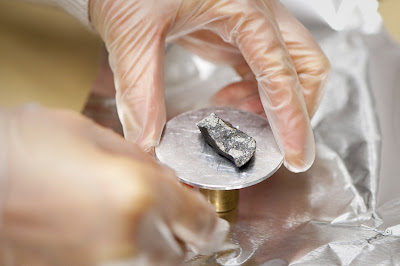As I'm sure you've heard by now last week, what is believed to be a meteor, passed into our atmosphere and exploded over Wisconsin. The light was seen as far away at St.Louis, MO and was captured on a camera at the University of Wisconsin-Madison. The video frames have been played on most news networks and are available everywhere online.
As you can imagine the 911 call center (actually 911 call centers over 6 states) was/were flooded with reports of the light, the sonic boom, and other observations. The NWS also noticed a new trail appear on the radar. I downloaded the level 2 data and plotted it up. First we'll look at the reflection.
You can see the trail in the SW corner of Iowa county. (KDVN radar) Next is just a blow up of this image. The meteor path was from west to east. According to NASA scientists the meteorite was likely not from the current Gamma Virginids meteor shower, but a rock from the asteroid belt.
Next it would be interesting to look at this trail in 3D. Using level II radar data this is possible. The next images show this from several different angles. The directions are labeled so it's easy to get bearings on which way you're looking. If you notice the trail is sloping down slightly towards the SE.
The average hight for the event was right around 24,000-25,000 ft. Looking at the plot you can see how small the plot was and how large the strongest reflector in the center is! A few back of the envelope calculations can be done using basic trig to determine some interesting things. You can try this yourself. I've posted a link to the radar data at the bottom and a link to a website where you can download a 21 day trail of GR2Analyst. Just open the data and start slicing it!







Pingback: Episode 162 – “Glowing ball of valuable metal” | Don't Panic Geocast